Dolomites beauty derives from a variety of spectacular vertical forms such as pinnacles, spires and towers, with contrasting horizontal surfaces including ledges, crags and plateaus. They rise abruptly above extensive talus deposits and more gentle foothills.
Countless legends have grown up in the shadow of these pale mountains, inspired by observation of the natural landscape and influenced by the stories told by the people.
The Dolomites must surely, in the popular imagination, be inhabited by fabulous creatures as well as by kings and queens, discover the The legend of the Pale Mountains, the Dolomites.
In this Article
“Come have a close look at this wonder, without a doubt one of the most beautiful, powerful and astonishing gifts from our planet…
Are they rocks or clouds?
Are they true or the products of a dream? “
Dino Buzzati, The Glass Mountains, 1956
The Dolomites take their name from the carbonate rock ‘dolomite,’ named for French geologist Déodat de Dolomieu (1750–1801), who was the first, in the late 1700s, to describe this type of sedimentary rock, dolómia, made up of crystals of a double carbonate of magnesium and calcium (dolomite). The name Dolomites was coined in 1792 by the Swiss naturalist H.-B. de Saussure in honor of Dolomieu.
LEGENDS of the Dolomites
The stark, majestic contours of the Dolomites and their mysterious forests and little villages scattered among valleys, rivers and high pastures, seem to have come straight out of a book of fairy tales peopled by Kings, knights, damsels, salvans [A quaint, mysterious dwarf-like mountain folk] and woodland sprites.
Countless legends have grown up in the shadow of these mountains, inspired by religious feelings and by observation of the natural landscape and influenced by the stories told by the balladeers. The Dolomites must surely, in the popular imagination, be inhabited by the creatures of fables.
ENGLISH: The Pale mountains – The Dolomites
The Pale mountains – The Dolomites
Once upon a time to the south of the Alps there was a rich and fortunate kingdom. Its inhabitants lived a happy and carefree life. Except for one, the king’s son who married the daughter of the king of the moon. Because the intense silver light of the moon was damaging his eyesight. Fearing he would soon be blind, he felt obliged to return to Earth. He brought the beautiful daughter of the Moon King with him, as his bride.
The princess found immense pleasure in the rich multi-coloured beauty of the meadows and the intense blue of the mountain lakes. But the dark and dismal colour of the high peaks, that jutted up like dark monsters towards the skies troubled the princess’s soul with burdensome thoughts. And so she became seriously ill due to the melancholy that she felt for the white lunar countryside and she had to return to the moon. Back in her own homeland she healed immediately, but the nostalgia she felt for her beloved husband on Earth was almost killing her. Having been left alone on Earth the prince too was unable to find peace and he was deeply troubled by the painful absence of his bride.
All alone he would wander the forests and one nights when there was a full moon he would stay awake, absorbed by tireless contemplation of the moon. One night he met a gnome in the forest – the king of the Salvans – he told the prince about his cruel destiny: Defeated he was now wandering from valley to valley with his people, failing to find a dwelling place. The prince too opened his heart to the gnome and told the story of his own destiny. The small man with a long beard had a solution:
The Salvans would cover the dark mountains with a blanket of bright treads of light. In exchange for the prince to allow the gnomes to dwell within his kingdom. The prince agreed and the king promised that on the first full moon he would fulfil his promise.
The Salvans started spinning silvery moonlight and covered the mountains with a web of light. The dark color disappeared and the summits shone with a silvery white moonlight.
The prince brought his bride back to the Earth and the Pale Mountains can still be admired today and called DOLOMITES. The prince’s kingdom no longer exists but the Salvans still reside in the rocks, caves and forests of this enchanted land.
adapted from: K.F. Wolff and Dolomitensagen: Les plü beles liëndes dla Val Badia. Le più belle leggende della Val Badia. Die schönsten Sagen aus dem Gadertal. Uniun Ladins Val Badia, 1993.
LADIN: I Crëp Slauris
I Crëp Slauris
Al pò ester che nia düć sais che les Dolomites vëgn inće tlamades Crëp Slauris, dô n strinët de morvëia sozedü ai tëmps dl Rëgn dles Dolomites, canche la pera di crëp â le medem corú dles Alpes. Te chësc rëgn êl prá curis cun flus frësches de vigni corú, bosc spësc y lêć incantâ. Indlunch, tut fora le ćiastel dl rè, dominâl cuntentëza y armonia. Mo i messëis savëi, che le fi dl rè â maridé la fia dl rè dla löna y n destin crüde condanâ i dui jogn a vire despartis por dagnora.
Le prinz ne soportâ nia la löm sterscia dla löna, che l’ess fat gni vêrc y la prinzëssa ne podô nia odëi i crëp scürs y i bosc da ambria, dèach’ara ciafâ tan la ria löna, ch’ara s’amarâ da dé a dé deplü. Al parô che vigni ligrëza foss oramai desfantada y le püre prinz â metü man da vire sciöche n salvare ti bosc scürs. Mo savëis che bele chisc bosc scürs ê popolá da creatöres suranaturales, bunes da cambié sënza ch’an s’l’aspetes, ći che dess pordrët sozede. Y n bel dé, canche le prinz rodâ indô bel su te bosch, êl rové pro le rè di salvans, n pice zbergl dër da orëi bun, che jô a chirí n post olách’al ess podü vire cun süa jënt. Dô ch’al â aldí la storia inchersciôra dl jônn, ti â le rè di salvans fat la proposta da fá gni lominusc i crëp de so rëgn, ala condiziun ch’al ess podü vire da śëgn inant cun süa jënt te chi bosc. Le prinz ê atira stè aöna y i salvans â firé por na nöt ntíera le lominus dla löna y â curì cun le fí d’arjënt i crëps dles Dolomites.
La prinzëssa â insciö indô podü gni söla tera, olách’ara â podü vire cuntënta adöm cun so om. Les Dolomites á ciafè l’inom de Crëp Slauris.
adapted from: K.F. Wolff and Dolomitensagen: Les plü beles liëndes dla Val Badia. Le più belle leggende della Val Badia. Die schönsten Sagen aus dem Gadertal. Uniun Ladins Val Badia, 1993.
GERMAN: Die Legende der Bleichen Berge
Die Legende der Bleichen Berge
Im Reich der Dolomiten schwirrten einst die piepsenden Töne der Vogelsprache durcheinander. Das Bild, das sich der Betrachtung seiner Bewohner bot, war von der Blumenvielfalt in den Wiesen, vom satten grün der Wälder und den kristallklaren Bergseen bestimmt. In dieser ihrer Welt herrschte das Glück bis zu dem Tag, an dem der Sohn des Königs eine Mondprinzessin heiratete. Die beiden liebten sich über alles, doch konnte der Prinz das gleißende Mondlicht kaum aushalten, seine Gemahlin den Anblick der grauen Felsen und dunklen Wälder überhaupt nicht ertragen. An ein gemeinsames Leben im Schloß war nicht zu denken, da er um sein Augenlicht bangte und sie vor Sehnsucht nach ihrer strahlend hellen Heimat fast verging und schließlich dorthin zurückkehrte.
Eines Tages, als der Prinz wieder einmal allein im Wald umherirrte, traf er den König der Zwerge, der nach Siedlungsland für sein Volk Ausschau hielt. Nachdem er sich die traurige Geschichte angehört, versprach der Zwergenkönig dem jungen Prinzgemahl im Austausch gegen die Erlaubnis, sich mit seinem Volk in den Wäldern häuslich nierderzulassen, die Berge des Reiches der Dolomiten in hellem Glanz erscheinen zu lassen. Der Bund wurde durch Handschlag besiegelt und in der darauffolgenden Nacht fing das Zwergvolk das Mondlicht Strahl für Strahl ein und überzog damit die Felsen.
Mit der Rückkehr der Mondprinzessin kehrte auch das Glück wieder in das Reich der Dolomiten ein.
adapted from: K.F. Wolff and Dolomitensagen: Les plü beles liëndes dla Val Badia. Le più belle leggende della Val Badia. Die schönsten Sagen aus dem Gadertal. Uniun Ladins Val Badia, 1993.
ITALIAN: I monti pallidi
I monti pallidi
Forse non tutti sanno che le Dolomiti vengono chiamate anche Monti Pallidi a seguito di un prodigioso incantesimo avvenuto ai tempi dell’antico Regno delle Dolomiti, quando la roccia delle montagne aveva lo stesso colore delle Alpi. Tale regno era ricoperto di prati fioriti, boschi lussureggianti e laghi incantati.
Ovunque si poteva respirare aria di felicità e armonia meno che nel castello reale. Bisogna infatti sapere che il figlio del re aveva sposato la principessa della luna, ma un triste destino condannava i due giovani amanti a vivere eternamente separati. L’uno non poteva sopportare l’intensa luce della luna che l’avrebbe reso cieco, l’altra sfuggiva la vista delle cupe montagne e degli ombrosi boschi che le causavano una malinconia talmente profonda da farla ammalare gravemente. Ormai ogni gioia sembrava svanita e solamente le oscure foreste facevano da solitario rifugio al povero principe. Ma si sa, però, che proprio le ombrose selve sono luoghi popolati da curiosi personaggi, ricchi di poteri sorprendenti e capaci di rovesciare inaspettatamente il corso degli eventi. Ed è così che un giorno, nel suo disperato vagare, il principe si imbattè nel re dei Salvani, un piccolo e simpatico gnomo in cerca di una terra per il suo popolo. Dopo aver ascoltato la triste storia del giovane sposo, il re dei Salvani gli propose, in cambio del permesso di abitare con la propria gente nei boschi, di rendere lucenti le montagne del suo regno. Siglato il patto, gli gnomi tessero per un’intera notte la luce della luna e ne ricoprirono tutte le rocce.
La principessa potè così tornare sulla terra per vivere felicemente assieme al suo sposo e le Dolomiti presereo il nome di Monti Pallidi.
adapted from: K.F. Wolff and Dolomitensagen: Les plü beles liëndes dla Val Badia. Le più belle leggende della Val Badia. Die schönsten Sagen aus dem Gadertal. Uniun Ladins Val Badia, 1993.
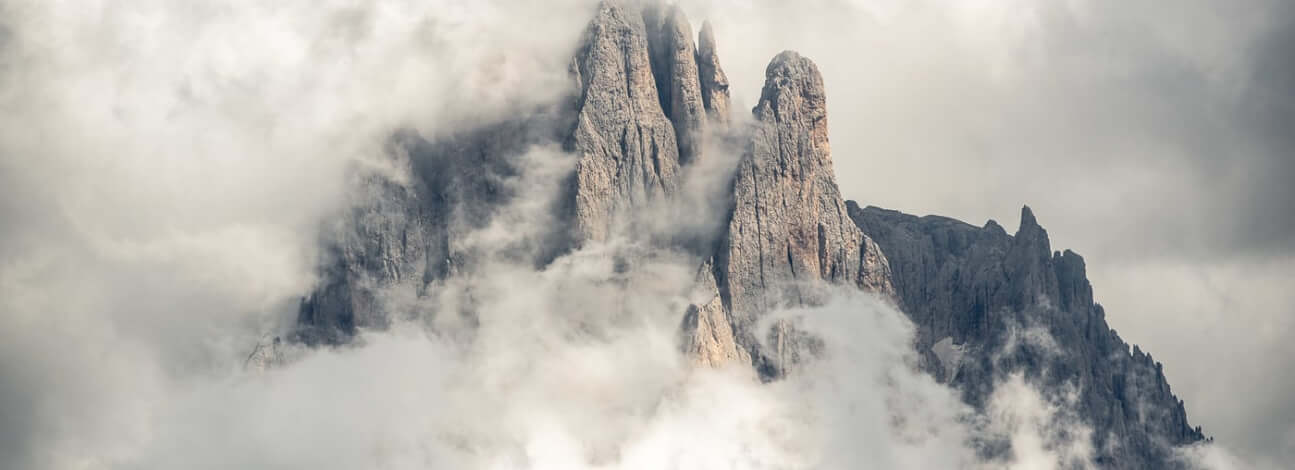
The legend of the pale mountains of the Dolomites is one of the many stories retold by Karl Felix Wolff in his collection of legends from the pale mountains “Die Bleichen Berge: Dolomitensagen” oder “I Monti Pallidi: leggende delle Dolomiti”. 1931. Here is the long version of the story:
The Legend from the pale mountains
Once upon a time there lived the son of a King. His father’s since kingdom lay in the southern territory of the Alps, with its green pastures and shady forests and steep mountains with black rocks.
The inhabitants lived as hunters and shepherds, loved their country, and considered themselves happy. One, alone, was not content with his life and the world about him-the King’s son. He felt tormented by a desire which no one could grant him-he wanted to visit the Moon. He had already consulted all the wise men of the kingdom as to what he should do in order to reach the Moon, but nobody knew how to advise him.
The Prince, therefore, was discontented and sad. In vain his companions endeavoured to distract him and to turn his thoughts to other things-he talked and dreamed only about the Moon. At the time of Full Moon he always became very sad. From evening until morning he wandered restlessly around on the rocks and meadows, gazing all the time at the Moon. The most expert physicians came to the Court but no one was able to cure the strange malady of the Prince. And it continued to become worse.
The Prince and the Alproses
One day, while hunting, the Prince left his companions and lost his way in the forests. When evening came and the sun had set he found himself in a lonely, high valley, all covered with Alproses, and surrounded on three sides by steep ridges and mighty towers of rock. No longer hoping to meet with his hunting companions again that day, the King’s son decided to spend the night there. So he lay down on a, green lawn in the midst of Alprose bushes and looked thoughtfully, in the distance, at the red clouds and mountain-tops which were just fading away.
As he felt very tired, however, he soon fell asleep and had a curious dream…..he stood on a meadow all covered with strange flowers, and spoke to a wonderful girl whom he had never seen before. All around, as far as the Prince could see, it was white, but he himself held some red Alproses in his hand, and gave them to the beautiful stranger. She, smiling, accepted the flowers, asking him what his country was like, and after a while she told him that she was the daughter of the Moon King. On hearing these words the King’s son felt an indescribable joy, and awoke.
It was already past midnight; the Moon stood high, and its silver light shone into the deserted clefts and on the pointed rocks of the lonely high valley: the Prince looked up and his joy changed, becoming deep sorrow. The usual ardent longing took possession of him, and for a long time he gave free play too his sad thoughts. Finally a gentle breeze passed through the Alproses, and the King’s son thought of what should happen if he really should meet the Moon Princess. So he began to gather the beautiful Alproses and to make a bouquet, and he was occupied with it for a long time.
All at once he thought he heard someone speaking high up in the rocks. He listened, but a great silence ruled, except that in the distance a waterfall murmured. The Prince gathered some more flowers, but for the second time he heard words, and now very clearly. The sound came down from the highest rock tower, and the top of this tower was wrapped up in a thick white cloud. Up there mountain-demons have to dwell, so the King’s son thought, and he grasped the hilt of his sword. Without putting away the Alprose bouquet he slowly strode to the tower, went around the foot of the mountain walls and began to climb up on the back wall which was not so steep. The speaking became more clear, but it was not yet possible to distinguish words. Soon the King’s son came into a cloud, the moonlight could no longer get through, and he only groped his way forward. Finally he struck something hard, a door was opened, and the Prince stood before a brightly illuminated little space where two very, very old men were sitting. They rose, frightened; but he calmed them, excusing himself by saying that he was a hunter who had lost his way in the mountain wildness. On hearing these words both went to meet him, asking him to come in, and they became very friendly. They talked of one thing and another, and the Prince asked them if they were old men of the mountains.
The Prince goes to the moon
But the two old men replied that they were inhabitants of the Moon who had made a long journey all around the world and that they were on the point of returning to their own country. Hearing this, the King’s son became quite pale with excitement and he told them that for years and years he felt an ardent desire to make a journey to the Moon. The two old men laughed, saying that if he wished to join them they were quite content, and that they were starting -immediately. The Prince was very happy, thanking the good old men with endless words. Meanwhile the cloud had drifted from the rock summit and began to sail towards the Moon with increasing speed. During the long journey the Prince told the two old men many things concerning his father’s kingdom, and they told him how things were on the Moon, and how one had to live there. Thus they informed him that an inhabitant of the earth could not stay for a long time on the Moon because everything there was white-plains and mountains, plants and cities – all shining in silver sheen, and an inhabitant of the earth became blind, after a time, from this dazzling brightness. So also, said they, a Moon dweller could not remain for a long time on the earth because of the dark colours of the forests and rocks, which are saddening, and if such a one could not return soon, very soon, to the Moon he would surely die from too much pining for the white fields of his country.
The Prince meets the Moonprinces
With such conversation and considerations did the three Moon-travellers beguile their time. At last the cloud on which they were, came down upon one of the mountains, of the Moon and rested there. The first part of their journey was over, now they had to proceed on foot. The two old men explained to the Prince that they had to turn westwards, and they advised him to travel towards the east in order to reach the Capital as soon as possible. The Prince said good-bye and went down the mountain in an easterly direction.
All the country around about was white, especially because of little white flowers which covered the surface of the Moon in endless numbers. But, in addition, the ground, which in some places was bare, appeared white, and even the flaming walls of rock had faint bright colours. After a while the King’s son saw the houses and tower tops of the Capital. All these buildings, however, were made, from their foundations to their battlements, of white marble. With quick steps the Prince hastened to meet this white splendour until he was stopped by a hedge which barred the way. This hedge was made, with great skill, of sparkling metal, and its sticks bore strange decorations. Beyond the hedge a gardener was working. As soon as he noticed the stranger he advanced slowly, saluted, and inquired, in an astonished manner, as to the origin of the red flowers which the Prince was holding in his hands. These were the Alproses which he had gathered during the night. The Prince explained that he had come from the earth, and that the flowers grew there. Now, the gardener told him that in the castle, which stood in the background, lived the Moon King and his daughter. The Princess was very fond of rare and beautiful flowers, and she would surely reward the stranger in a royal manner if he would leave the red bouquet for her. The Prince laughed and said that he would give his Alproses to the Princess with great pleasure, but that he would seek no reward for them as he himself was the son of a King. At this the astonished gardener opened the gate, and invited the stranger to enter the garden. Then he ran up to the castle. After a while he returned, breathless, begging the Prince to go with him to the castle. The King’s son followed his guide through many, many halls and corridors, looking amazedly at the walls of alabaster white, and at the bright arms which adorned them.
The Prince was received by the Moon King and his daughter in a large illuminated hall, and was welcomed in a very friendly way. The Moon King was a very old man with a long silvery white beard; but, on seeing the Princess, the Prince recognised that wonderful girl whom he had met in his night dream. She accepted the Alproses gratefully, praising their glorious colour, and asked the Prince if there were many such flowers in his country, what kind of people lived there, and how large was his father’s kingdom. It was only after a lengthy conversation that they parted, the Moon King telling the Prince that he was to consider himself as his guest.
The Prince remained then for a time at the royal castle, taking long walks through its surroundings, and became well acquainted with the Moon to which he had so often looked up with longing. After some weeks the Moon King asked his foreign guest, at lunch, how he liked the Moon. The Prince replied that the white, shining landscape of the Moon was the most beautiful he ever had seen, but it’s unaccustomed brightness was so affecting his eyes that he feared he would go blind if he did not return soon to his own country. The Princess interjected that she did not share the apprehension of the earth Prince, and that with time he could accustom himself to the splendour of the landscape. A wise old courtier, however, ventured to contradict the Princess, saying that it really was not advisable for an inhabitant of the earth to remain too long on the Moon. After that the Princess said no more.
The Prince comes back, bringing with him the Moon Princess as his wife.
At the time that the King’s son lost his way while hunting, his companions searched for him everywhere in the gloomy forests and among the pathless rocks, but though their quest lasted for many days they were unable to find him. They were obliged, then, to return to the royal castle and to inform the old King of what had happened, but he sent them away, warning them that they should not dare to appear before him again without his son. At the same time the whole kingdom was informed that anyone who could bring any tidings of the Prince might expect a great reward. But it was all to no purpose. No one knew anything, and the Prince was not heard of again.
How the Edelweiss came to earth
Everyone believed that he had perished at night on the mountains, when suddenly, it was reported through the country that the Prince had come back, bringing with him the Moon King’s daughter as his wife. The simple people of the Alps were -very glad, and they all went too the palace to try to see the Princess as they could not imagine what an inhabitant of the Moon should look like, but she differed only from the women of the earth in that a bright light seemed to emanate from her, and that in the meadows each tree shadow vanished as soon as she appeared. The people were astonished at the white flower which grows everywhere on the Moon, and which the Princess had brought with her. This flower spread with time over the whole Alps, and even to-day the bright stars salute one from the rockwalls -they are called Edelweiss.
The Princess for her part was enchanted by the coloured meadows and pastures of the Alps, never getting tired of admiring the -variegated flowers and the green lawns. She also loved the blue mountain lakes, and, ever and always, she praised the -variety of the earth surface, comparing it with the monotony of the Moon landscape, where everything was white. A proud satisfaction came over the Prince when he saw that the Moon daughter was so well and happy, and he delighted to show her everything, the -valleys of the kingdom and their different curiosities, and all the beauties of the country. Both of them felt very glad and cheerful, and had no other thought but to remain like that.
The Princess misses the white moon landscape
Once, however, when the King’s son returned late one evening from hunting he saw his wife standing on the balcony and looking up at the Moon. He thought it was strange. He went up softly, surprising the dreamer, and asked her why she was looking up so thoughtfully at the Moon. She smiled and was silent, but on being asked again she confessed that she had been pining for the white Moon-fields, The meadows and valleys of the Alps are beautiful, she said, but the confusion of dark mountain tops which extend themselves threateningly towards the sky, like the black fists of gigantic demons, give the landscape a gloomy closeness, and this in time presses like deep sorrow upon the soul. On hearing this complaint the Prince grew afraid, for it recalled to his mind what the two old men said to him when he went up to the Moon: they said that a Moon dweller would soon miss the white beauty of his country and die, languishing for light …
At present, of course, there was no cause for a serious fear, and the Prince hoped to be able to release his wife from her dangerous home-sickness by amusement and all kinds of diversion. He was mistaken, however, for her condition became worse little by little. Just like the Prince before his journey to the Moon, she now gazed at the Moon for hours and hours, becoming finally so pale and weak that there were grave fears for her life, and always she lamented about the black rocks which threatened down in such a ghostly way, just as if they would darken the valleys. And just as once no one was able to help the Prince, so now, also, nobody could bring deliverance. In the meantime the suffering of the Princess was becoming worse, and the words of the two old Moon dwellers seemed to be terribly true.
The Prince felt desolate, and those about him were helpless.
The Moon King takes his daughter and the Prince back to the moon
As soon as the Moon King heard that his daughter was in danger of death, he left the Moon and came, down to the earth to visit his son-in-law who told him about her terrible home-sickness, which grew worse and worse and was now about to kill her. The Moon King said he could not let his daughter die, and, therefore, that he wished to bring her back to the Moon. At the same time he invited the Prince in a very friendly way to accompany them if he wished to do so, but said that in case the Prince should be obliged to stay on the earth he would be very sorry, without, however, being able to change his resolution to take the Princess back to her country.
Now people from all parts besieged the Prince, begging him to think of the kingdom he was appointed to rule, to remain among his native mountains and to renounce his wife. They praised the great future he had before him, advising him to undertake a campaign in the beautiful south, but the Prince would listen to no such speeches, and went with his father-in-law and his sick wife to the Moon.
The prince returns to earth
Here she recovered her health very soon, but long before she was perfectly healthy the Prince perceived with horror that he was seeing less from day to day and that he would be blind after a short time. The old Moon King now advised him to leave the Moon before it was too late. The Prince struggled against it, but seeing the danger growing more and more apparent he finally gave it up and returned, wretched, to the earth.
Now the Moon-home-sickness took hold of him more strongly than ever. At full Moon time he was never to be seen in the castle, but was wandering restlessly around on the mountains. During the days he slept in caverns and under trees, and at night he climbed high peaks, looking steadfastly up at the Moon. With the new Moon- then, the Prince would return but so changed that scarcely anyone could recognise him. Eventually it wearied him to see people at all, and he no longer went down to the valleys, so completely wild did he become. Ceaselessly he traversed the large forests and rock deserts of his kingdom, climbing every mountain-top. Nowhere could he find consolation and peace.
The prince meets the dwarf king
Many weeks had passed since the King’s son had last seen or spoken to anyone. One evening, in a rubbled valley-end, he was surprised by a thunderstorm and obliged to flee into a cavern. There he met a strange little man, hardly three shoes tall but with a long beard and a serious face and a golden crown upon his head. The Prince spoke to the little man and soon realised that he had found a fellow-sufferer, for what the little man with the golden crown had to tell about his fate was very pitiful and sad. The little man was the king of the “Salwans” (Salmon in Ladin language, signifies cavern-inhabitant, wild man.)
From olden times they had inhabited a beautiful kingdom in the far east. This kingdom, having reached the height of its glory, and possessing as many inhabitants as a large forest has leaves, was subjected to an invasion of hostile foreign forces who devastated the country by fire and sword and killed so many Salwans in protracted battles that the survivors had to flee from their own country. Then the king, with the remainder of his people, marched from one neighbouring kingdom to another begging for a mountain, or a marsh, or some other piece of ground so that his people could settle there. No sovereign would listen to him, however, and everywhere the Salwans were ejected with scorn. At last they found shelter in a distant country, but they were obliged to work so hard that many of them ‘died and other’s escaped in order that they might not witness any longer the misery of their brothers. Thus it was with the king.
Having related this, the little man sighed and said that no creature could be more unhappy than a sovereign whose people had entirely perished and he unable to prevent it. The Prince then sympathised with the dwarf king on the hard fate which had befallen him but he said that his own destiny was no less cruel and he, too, related his distressful history.
The king of the Salwans has an idea
At first the dwarf king listened with a gloomy look but, little by little, his face began to brighten, and at last he smiled, quite pleased, and when -the Prince, who did not notice this, had finished, the little man jumped up, clapped his hands and cried out joyously: Prince, be happy, we are now both saved. On hearing such a ‘ n unexpected exclamation the Prince was almost afraid to look at the dwarf, for he thought that the little man had surely lost his reason and gone crazy. But the dwarf king had not spoken without reason and he now began to explain his meaning quite clearly. He pointed out that the Princess was only obliged to return to her own country because a Moon child, accustomed to light could not bear the look of the black rocks for long. If the mountains of the Alp-kingdom were of the same clear colour as those on the Moon, the Princess would never have been attacked by such a home-sickness.
The little Salwans, he said, are a clever and skilled people and they would be willing to cover the innumerable dark mountain tops, from head to foot, with the whiteness of the Moonlandscape if only the King of the Alp-kingdom would give them permission to live there for ever without being molested. This would give help to both, to the Prince as well as to the dwarf-people.
The Prince listened to this promising speech half astonished, half unbelieving, and then he said he did not think it would be difficult to obtain permission for the Salwans to remain in his kingdom but that he did not understand how they could make a dark rockwall white. The dwarf-king smiled in a superior way and said the Prince could rest assured about that because the dwarfs had already done things which were more difficult. The Prince then hesitated no longer, inviting the little man to come with him to the court. The Salwan agreed, and as, in addition, the storm had ceased, they immediately left the cavern, walking on together. They had to wander for two days through desert solitudes before they reached the principal valley and the castle.
The old King was very pleased at the return of his son but he considered the request of himself and his companion a strange one. He did not bother about the look of the mountain-tops but he thought he could not agree to the immigration of a strange people. It was only when the king of the Salwans had explained that they would never lay claim to the rich valleys, meadows and fields, but be satisfied to remain in the f orests and wild rocks, that the Alp King and his advisers gave their consent. The agreement was confirmed by documents and both parties swore to observe it faithfully.
How the pale mountains came to be
The dwarf king departed immediately to look for his poor people and to bring them the good news. Some days later the exhausted little people were seen to cross the frontiers of the kingdom in long columns and turn towards the high mountains. After having selected their dwelling places under clefts and rocks and behind waterfalls, the dwarf king sent word to the Prince that the Salwans would begin next evening the work they had undertaken by contract. The Prince who could scarcely restrain his impatience was, in addition, tormented by doubts, for it seemed incredible to him that the dwarfs would be able to accomplish the difficult work. He ascended one of the highest mountain-tops to await the evening. As soon as the Moon had risen, seven Salwans appeared, forming a circle and beginning to make all sorts of strange contortions. Their little hands worked convulsively, like the waves of a torrent. Astonished, the Prince watched this performance; finally he asked the little men what they intended to do. They answered that they were about to weave the moonlight, and, surely enough, after a while, in the middle of a circle, one saw a clew which radiated a soft but continuing brightness. The dwarfs worked busily, the clew was growing and it became a large bundle. The Prince gazed steadily at the seven little men, while hour after hour passed. Then he looked in the distance and, behold, on every mountain top a point of light was glowing: everywhere stood little dwarfs who had spun the lights. In deep astonishment the Prince looked on this wonderful picture; the stars seemed to have fallen down on the dark sea of mountain tops. Already the valley had become all black, and the Moon shone only on the highest peaks, then it sank down beyond long wavy borders. The Salwans did not rest but immediately began another task; they pulled apart their bundles of light, drawing glittering threads down from the tops over the declivities, and they went around the mountains wrapping them, little by little, into a net of light. As soon as every edge and top had been spun over, the meshes were drawn closer together until finally, every dark plain vanished and the whole ground radiated a pale glimmer.
The next day no one, down in the valley, could believe their eyes, for the high mountains all around, once towering aloft so gloomily, were now all white, and their bright colour formed a strange contrast with the maze of mountains which remained black beyond the frontier. In a single, night the dwarfs had covered all the mountain tops in the kingdom with the white colour of the Moon-landscape. When the Prince arrived at the castle. highly pleased, a messenger was brought before him with a sad message: the Moon King informed the Prince that the Princess had contracted an illness which endangered her life, and had expressed a desire to see her husband once again. The Prince made no answer, not even a single word, but when the messenger departed he was his companion. As soon as he arrived on the Moon, he hastened towards the glittering palace. On reaching the hall the Prince was informed that the Princess was on the point of death. But he ran to her, crying that she must not die now, for all their sorrow was ended: the mountain tops of his kingdom were glittering like Moon mountains; she must return with him once more to the earth, as he had prepared for her a world of white where she would never again have to languish for light, because every high mountain top in his country had now become a flame of stone, flaring resplendently to the clouds.
The Princess comes back to earth
These cheerful, happy words revived the spirits of the Princess, and soon it was obvious that she had recovered again. After a short time the Prince was able to bring his wife back to the earth, and how joyful was the astonishment of the young Princess who had lain so near to death, when she beheld the shining landscape: the smiling Alp-garden united in its white rocks, green meadows and variegated flowers, the Moon’s regions of light with the rich colour-beauty of the earth. Never again did the Moon-daughter sigh for her own country, as it was now more beautiful on the white mountains than in the Moon.
The pale mountains are standing there today, and they are called the Dolomites. The kingdom as such has ceased to exist for a long time, but the Salwans still dwell in the wildness of the rocks and forests.
But not only does an enchanting brightness still cling to those pale mountains-they are haunted by the deep home-sickness of that Moon-Princess, for anyone who has ever been there, is always called back to the marvel of the light-girded Dolomites bv an infinite longing.
But not only does an enchanting brightness still cling to those pale mountains
– they are haunted by the deep home-sickness of the Moon-Princess –
for anyone who has ever been there, is always called back to the marvel of the light-girded Dolomites by an infinite longing.
There are indeed many more stories full of magic and mystery woven around these magnificent peaks and corners of the Dolomites. Have you heard about the interesting phenomenon, the so-called Alpenglühen in German, in Italian riverbero rossiccio and Enrosadira, is the Ladin term for the alpenglow. During sunrise and sunset the Dolomite rocks are covered in red color tones. The mystic legend of King Laurins Rose Garden talks about this phenomenon.

Legend: On the origin of the Edelweiss in the Dolomites
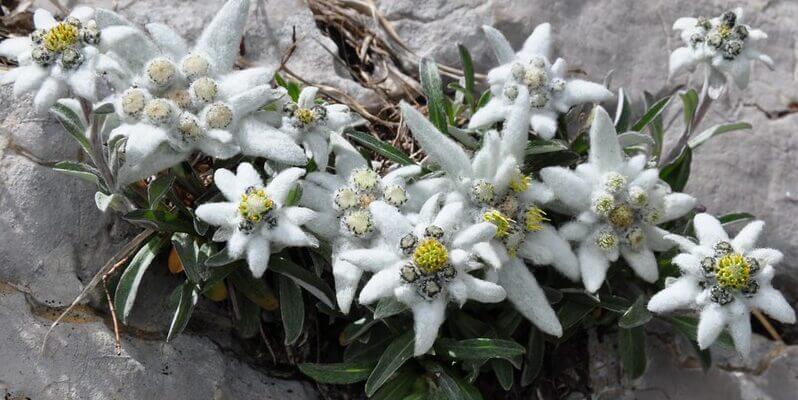
The Ladin population, the oldest people of the Dolomites mountains, has it’s own story about a white starshaped flower. It’s connected to the legend of the Pale Mountains:
A prince married the bright daughter of the Moon. She was different from the earthly women in that her body emanated a gentle splendour and soft light. She brought white flowers to the Earth that caused much wonder also. This flower spread with time over the whole Alps, and even today the bright stars salute one from the rock walls, they are called Edelweiss.
The flower’s common name ” Edelweiss” derives from the German word “Edelweiß”, which is a compound of edel “noble” and weiß “white”. In the Italian speaking Alps the flower is referred as “Stella Alpina”, while in the French Alps as “Étoile des Alpes”, both names meaning “Star of the Alps”.
Ethnobotany: Uses and Benefits of Edelweiss
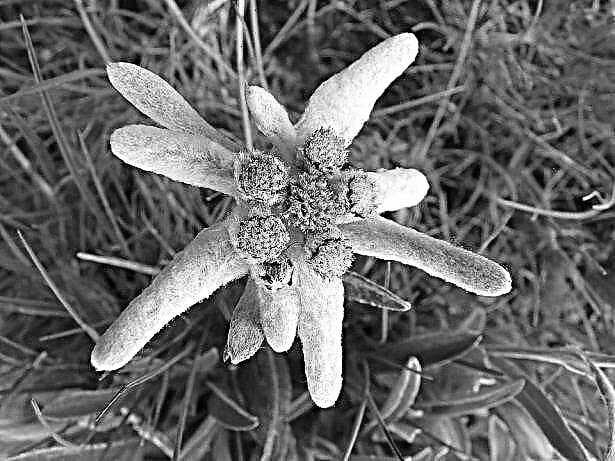
Edelweiss has a history of herbal medicine use. Today it is extracted for use in anti-aging serums and cosmetic treatments to soothe skin.
Traditional herbal formulas call for making the leaves and flowers into a tea for stomach pain.
The plant has no particular toxicity to pets or humans. There aren’t many bees native to the normal ranges for Edelweiss cultivation. In other areas, they are a good source of nectar and pollen and draw in pollinators with their fragrance.
The Dolomites do not only impress because of the interplay of colours, but mainly because of their varied landscape. Below the bright rock walls you see dark scree leading down to green meadows, which again border with dense forests.
Here and there you will find crystal-clear alpine lakes, which mirror the Dolomite Peaks. A varied flora and fauna has developed in this impressive landscape. Hares, squirrels, marmots, wolfs, bears, deers and chamois live in the mountains.
The flora is characterised by ground-covering moss, Edelweiss, blooming Alproses and mountain pine.
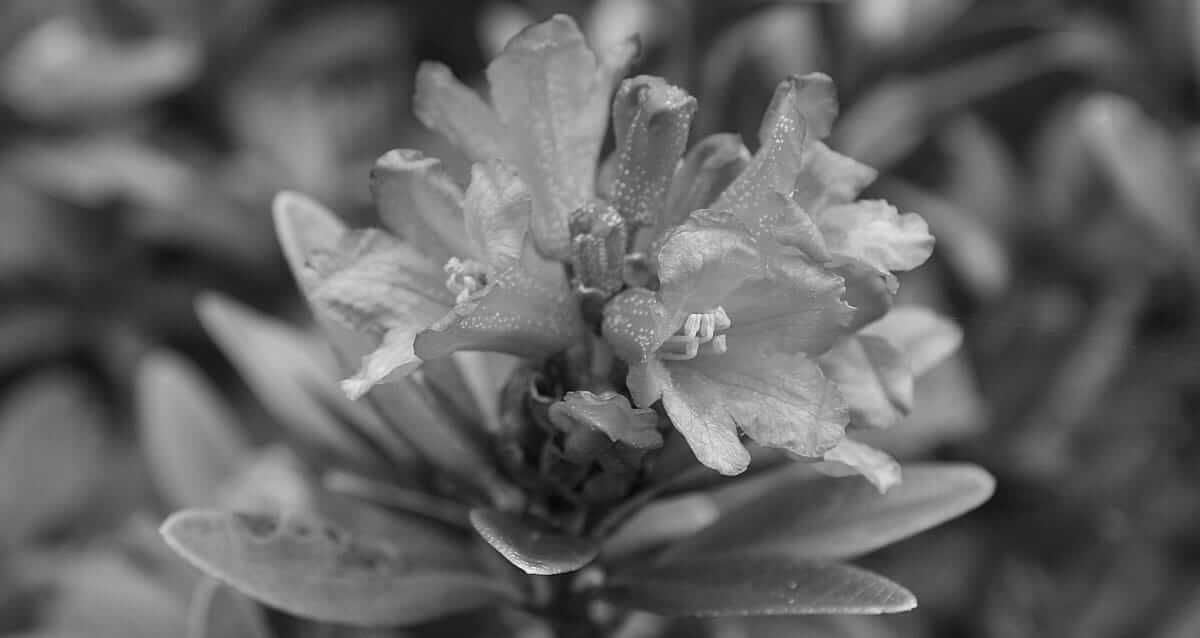
Discovering the Pale Mountains or Dolomites on a motorbike
The Dolomites are unparalleled when it comes to mountains that rise as peaks with intervening ravines, in some places standing isolated but in others forming sweeping panoramas.
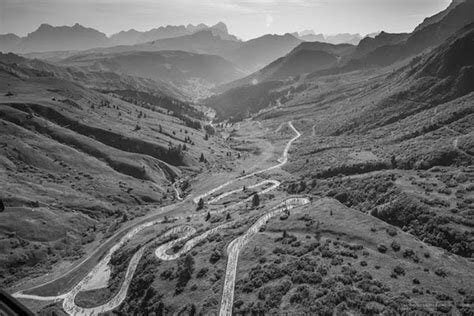
Some of the rock cliffs here rise more than 1,600 m and are among the highest limestone walls found anywhere in the world. and fine roads that span through this
spectacular scenery. The most characteristic feature of the Dolomite rock is its bright colour, ever since they are called the pale mountains.
All surreal in both scale and setting, check out the intro of the Sylvester Stallone film Cliffhanger to get an impression of the jagged limestone towers and huge precipitous cliffs, they shot this dramatic scene in the Dolomites.
The area does not only impress because of these pallid mountains, but mainly because of their varied landscape:
Wild alpine meadows, deciduous and evergreen woods, lunar landscapes, high altitude terrain, alpine lakes, soaring peaks, dramatic walls, and towering heights.
We know the Alps very well, as we spend many years there, we love the outdoors:
“Wow! I didn’t know that you had six toes?”
“Nah, that’s just a blister!”
Proper shoes and well cut toenails are a must in order to hike, track and climb the Dolomites. Riding the motorbike is spectacular, the Pale mountains feature an infinite number of paved roads winding their way through these wild landscapes, with breathtaking views adding to the drive.
Dolomites UNESCO world heritage
After emerging from an extinct tropical sea around 70 million years ago, the sharp limestone peaks of the Dolomites are some of the most beautiful alpine landscapes in the world, no wonder UNESCO has declared the Dolomites a World Heritage Site in 2009:
“The site of the Dolomites comprises a mountain range in the northern Italian Alps, numbering 18 peaks which rise to above 3,000 meters and cover 141,903 ha.
It features some of the most beautiful mountain landscapes anywhere, with vertical walls, sheer cliffs and a high density of narrow, deep and long valleys.
A serial property of nine areas that present a diversity of spectacular landscapes of international significance for geomorphology marked by steeples, pinnacles and rock walls, the site also contains glacial landforms and karst systems.”
The UNESCO zones
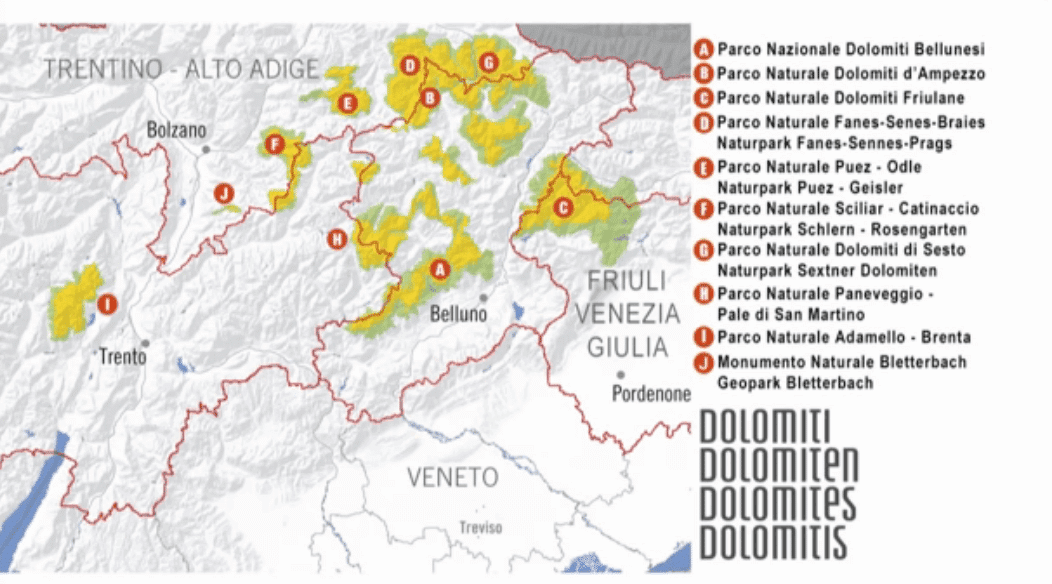

The nine Dolomites mountain groups are spread over five provinces: Trento, Bolzano, Belluno, Pordenone and Udine connected by beautiful and challenging mountain passes. They are featuring thrilling curves, turns, hairpin bends and switchbacks while winding up and down – every pass links to new stunning views…
This are the mountain passes you can drive in the Dolomites:
|
|
Get up early, have a ride outside the main route and avoid to be stuck in traffic you might like to use the earthstoriez map, and enjoy the fun.
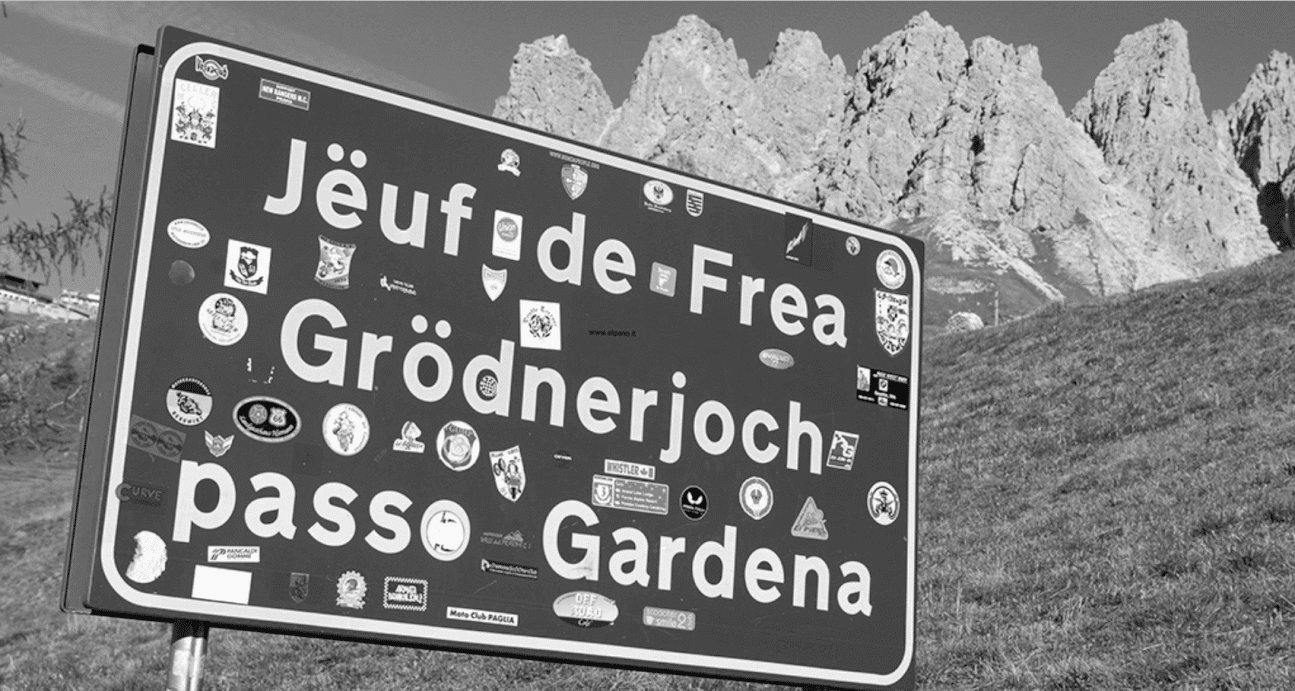
History of Southtirol
Because the people of the Dolomites are bilingual, even trilingual in some places, many villages and towns have both an Italian and Tyrolean name, and in the Dolomites a Ladin one too:
Culturally speaking are the Dolomites a fascinating border region between the Austro – Germanic linguistic area to the north and the Italian speaking southern section. Here three different linguistic groups are peacefully cohabiting – the Tyrolean German – speaking South Tyroleans, the Italian speaking inhabitants and the Ladins , a linguistic minority group speaking a language based on the Latin spoken by the peoples of the area during and shortly after the Roman (!) occupation of the Dolomites.
When you travel to the South Tyrol, you may encounter any of these languages:
“Salve!” (a formal Italian Hello), “Guten Tag!” (Hello in German), or “Bun dé!” (Good Day in Ladin).
The Three Languages of South Tyrol
South Tyrol (known as Südtirol in German and Ladin, as well as Alto Adige in Italian) was part of the Austro–Hungarian Empire for 550 years until it was annexed by Italy at the end of the First World War.
Most Italian toponyms are translations performed by nationalist Ettore Tolomei during the fascist Italianization of South Tyrol. After World War II, 1945, South Tyrol and the neighboring province of Trentino formed the autonomous region of Trentino-Alto Adige. The rights of the German- and Ladin – speaking minorities were officially protected under the 1948 Autonomy Statute.
But the South Tyrolean People’s Party began pushing for greater provincial autonomy in the mid-1950s, and in the 1960s German-speaking militants even carried out a series of bomb attacks against symbols of Italian state authority.
A revised statute came into force in 1972, devolving most powers to the provinces and setting up power-sharing between the linguistic groups in South Tyrol. German and Italian were both made official languages, also was Ladin recognized as an official language in the Ladin areas.
Every citizen has the right to use his own mother tongue, even at court. Ladin and German are tought at schools. All traffic signs are officially bi- or trilingual.
In order to protect minority rights there is proportionality for public jobs, housing and other benefits. This considerable level of self-government is given also due to the large financial resources of South Tyrol, retaining almost 90% of all levied taxes.
Language distribution:
Around 62.3% of South Tyroleans identify themselves as German speakers, 23.4% Italian and 4.1 % Ladin. 10.2% of the population speak another language natively (census 2011).
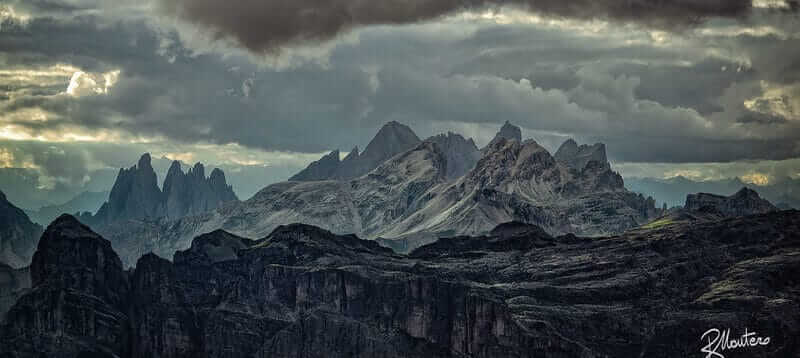
~ ○ ~
Keep exploring:
Works Cited & Multimedia Sources
- https://maxiloll.blog/2019/07/02/the-pale-mountains/
- https://www.micura.it/la/viac/cultura-ladina/i-creps-conta/lijendes
- https://www.micura.it/de/begegnung/ladinische-kultur/der-zauber-der-dolomiten/dolomitensagen
- https://www.micura.it/it/incontro/cultura-ladina/la-fascinazione-delle-dolomiti/leggende
- https://www.dolomiteslegends.it/en/
- Dolomites pics on flickr – https://www.flickr.com/photos/ljsilver71/36990529156/in/photostream/
- https://www.guidedolomiti.com/en/dolomites-unesco/
- Mahlknecht Bruno. Südtiroler Sagen.1981.
- Official website of the Dolomites UNESCO World Heritage https://www.dolomitiunesco.info/
- South Tyrol is a success story at a difficult time for majority‒minority relations. https://www.opendemocracy.net/en/can-europe-make-it/south-tyrol-is-success-story-at-difficult-time-for-ma/
- South Tyrol. https://web.archive.org/web/20210917045129/http://www.world-autonomies.info/tas/styrol/Pages/default.aspx
- South Tyrol. https://en.wikipedia.org/wiki/South_Tyrol
- The Dolomites https://whc.unesco.org/en/list/1237/
- The legend of the pale mountains of the Dolomites. http://www.sagen.at/texte/sagen/italien/legends_in_english/palemountains.html
- The South Tyrol question explained. https://www.thelocal.com/20181018/the-south-tyrol-question-explained/
- Wolff Carlo Felice. Leggende delle Dolomiti. I monti pallidi. 1989.
- Wolff Karl Felix. The Pale Mountains. Legends of the Dolomites.1989.
- Wolff Karls Felix. Dolomitensagen. Sagen und Überlieferungen, Märchen und Erzählungen der ladinischen und deutschen Dolomitenbewohner.1989.



